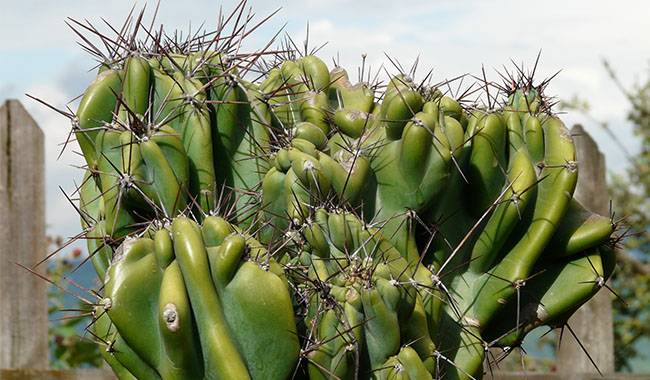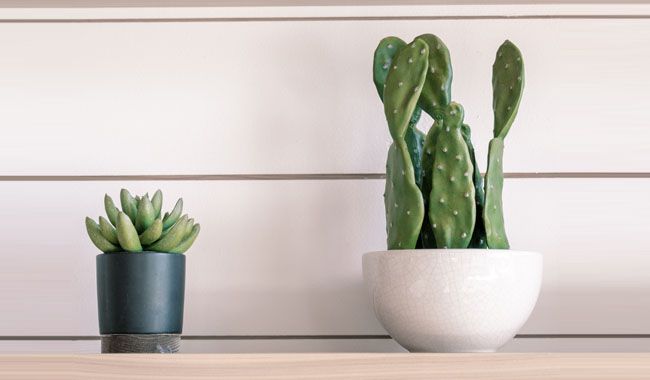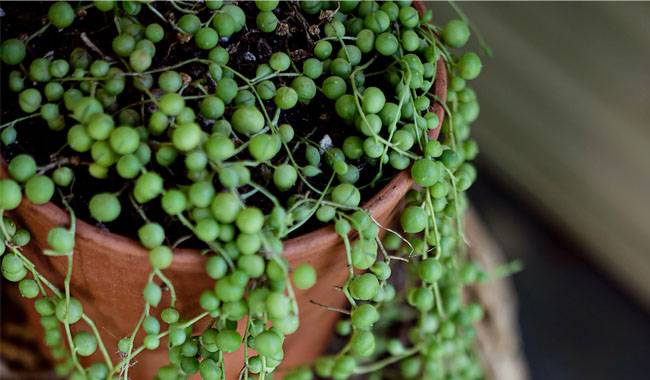
Even for the genus String of Pearls (Senecio Rowley), known for its diversity of forms, String of Pearls (Senecio Rowley) is an exceptional plant. One of the most decorative and extravagant succulents, it looks like a green necklace. The almost perfectly rounded globular leaves, interspersed with fine branches, form a stunningly beautiful cascade. A string of pearls (Senecio Rowley) is no less popular for its fragility or certain caprices. It is a resting star that is suitable for cultivation even for beginners but requires a cautious approach. That being said, String of Pearls (Senecio Rowley) is very easy to propagate. This article will explain how to plant string of pearls (Senecio Rowley’s). Care and propagation.
A STRING OF PEARLS PLANT DESCRIPTION
A string of pearls, or String of Pearls (Senecio Rowley), is one of the most recognizable and extravagant succulents and is rightfully considered a universal favorite. At least among all representatives of the String of Pearls genus, it is the most popular plant.
No matter what you call it: a string of pearls, green or emerald beads, a bunch of peas – it is still easily recognizable. It is an evergreen, fast-growing, ampelographic, very brittle, easily shattered succulent plant with long hanging branches and the odd shape of unusual spherical leaves.
The shoots are thin, almost filiform, and surprisingly stiff for such a fragile succulent, with branches up to 23 inches (60 cm) long and older plants up to 40 inches (1 m). They dangle gracefully from the rim of the container and root, where they come in contact with the soil. As the plants age, they become more lush and showy and form vivid cascades.
Although the leaves are far from perfectly round with their pointy tops, that’s exactly what people see as green beans. Juicy, fleshy, glossy, and 5-6 mm in diameter, they sit on short, fragile petioles that shatter very easily when touched. The light green, waxy blue surface has a translucent pattern that is only visible up close. There are some interesting variegated varieties of mottling that are considered a bit more capricious.
With its winter flowering, String of pearls is capable of surprising anyone. Admittedly, it only blooms after cool winters, sometimes skipping the blooming season unpredictably. Fluffy, thanks to conspicuous dark cherry-colored thick stamens, the single, almost circular baskets on the plant’s long pedicels appear to be interesting pale pink pompoms. Up close, it will surprise you with its sweet and spicy cinnamon scent.
The string of pearls is one of the more delicate houseplants. Due to its irritating sap, it is conditionally poisonous. In addition, contact with it can cause an unpleasant reaction to the skin.
GROWING CONDITIONS FOR STRING OF PEARLS
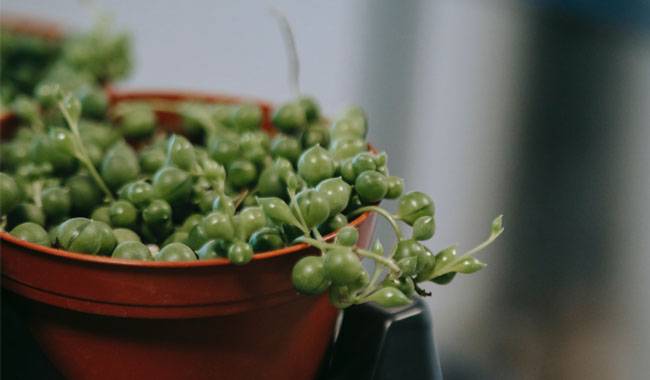
High light and temperatures except for extreme cold. String of pearls (Senecio Rowley) requirements are very simple. Only if you want the plant to bloom do you need to provide it with special care during the winter.
Lighting and placement
Thanks to its good adaptability, String of pearls grows well in bright light and light penumbra, with only slight variations in shades of color from bright to pale and cool. It is often affected by direct sunlight, especially when there is a significant change in the plant’s condition. Placing a String of pearls only on the windowsill is unnecessary, and in summer, he usually does not notice at a slight distance from the window. It is better to focus on conditions similar to those of the eastern windowsill. In the winter, additional light is needed.
Temperature and ventilation
The string of pearls can grow at any room temperature: where the owner is comfortable, also there. To enjoy flowering, you need to overwinter the cooler at 50-60 °F (10-16°C). If you can protect the plant from severe heat or compensate with fresh air, the density and growth rate of the plant will benefit.
Despite being indoors, this succulent plant will not refuse to move into the fresh air in the summer – temperatures should not fall below 44 °F (7 °C). Whether outdoors or indoors, you need to choose a place protected from the wind.
CARING FOR STRING OF PEARLS AT HOME (SENECIO ROWLEY)
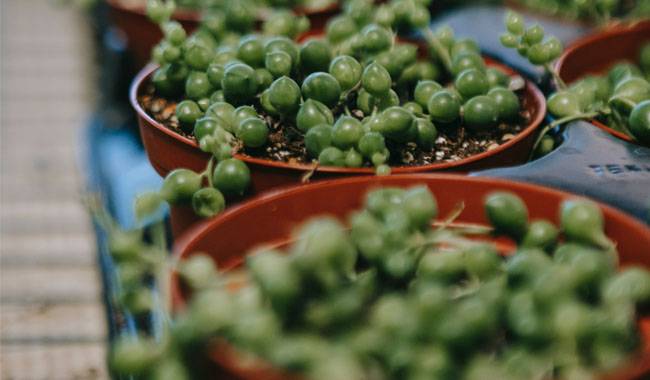
The string of pearls prefers steady light humidity and as little contact as possible, requiring only simple regular care. But it will not forgive watering mistakes.
Watering and humidity
This is not the most drought-resistant succulent, and when the soil is completely dry for long periods, it becomes more brittle and stops growing. But overwatering is even worse, as its shoots will soon rot. To avoid all risks, it is best to let the substrate dry 1-2 inches (2.5-5 cm) before each successive watering with a small amount of water.
If you don’t have an indicator, waiting 1-2 days after the substrate has dried is a good idea instead of checking by hand. Watering once a week is sufficient in summer and twice a week in high temperatures. By winter, String of Pearls (Senecio Rowley) is moved to drier conditions, reducing watering by 2 to 3 times.
Many succulents do not require high water quality, but a string of pearls can only be watered with soft water, meltwater or rainwater.
Fertilization and Fertilizer Composition
Fertilization is not allowed at all for String of Pearls for one year after transplanting. This succulent requires only a small amount of fertilization during the active vegetative period. A regular application of succulent fertilizer should be applied once a month in the spring and summer at the dose specified by the manufacturer.
Pruning and Trimming String of Pearls (Senecio Rowley)
In this plant, only those shoots that have become too long lost all their foliage, or have been damaged are selectively cut back. There are also the oldest shoots that are no longer decorative. Branches do not need to be cut to the base, and damaged parts can be pruned.
To get a lush waterfall from young plants as soon as possible, you can use a simple pruning method in the spring by attaching new cuttings or short, long cuttings to the substrate, covering them with a small amount of soil, and rooting them in the same pot.
Transplanting, containers and substrates
Transplanting without demand should not be done. The string of pearls will only “move” to new containers if they have mastered the previous cache or a problem with the soil.
Choose containers carefully: they must be stable and not topple over under many shoots, often on one side, but keep them light – very dark containers String of pearls (Senecio Rowley) do not like, even if laid with high drainage.
Special substrates for cacti and succulents are ideal for growing String of pearls. Sand and loosener should always be present in the mixture, but it is equally important that the soil is sufficiently nourished. With the addition of perlite or sand, the plant can be grown in a good quality general-purpose soil. The optimal pH is 5.0 to 6.0.
When transplanting, the main thing is to handle the shoots carefully to avoid injury and leaf drop. The level of submergence should be kept constant. A 1-2 inch (2.5-5 cm) drainage opening should be placed at the bottom of the container.
PESTS, DISEASES, AND PROBLEMS IN CULTIVATION
As resistant as other indoor succulents, this cruciferous plant cannot boast of itself. If not correctly cared for, the plant becomes more susceptible to spider mites, aphids, and mealybugs. Pests can be controlled with biological insecticides, decoctions of insecticidal plants (onion, garlic, marigold, red pepper, dandelion), and ash infusions.
Strong pruning of damaged parts will allow new, healthy shoots to grow and allow new plants to replace them. Chemicals should be used only as a last resort.
Under conditions of excess water, high air humidity, and excessive cold, String of pearls can suffer not only from different types of root and stem rot but also from powdery mildew. Dry spots with yellow edges easily recognize gray rot. Even the strongest fungicides will not help if the damaged parts are not cut back.
PROPAGATION STRING OF PEARLS (SENECIO ROWLEY)
The fastest way to get a strong bush is to divide the cross of String of Pearls into several parts. But you still can’t do this without partial loss due to root injury. Cuttings, which require more patience but are less risky, are the best option.
Cuttings 2-4 inch (5-10 cm) long shoots with sun-dried slices can be rooted.
- Simply lay them on a lightly moistened substrate and secure or slightly sprinkle with water.
- Plant them as normal plugs and remove some of the lower foliage.
The soil mixture should be loose and light; coconut substrate, perlite, and pure sand can be used. Mulch is not necessary, but the soil moisture should be light and constant. To ensure that the bush achieves a decorative effect more quickly without having to enjoy only a few stems over several years, it is best to take several cuttings in a pot or re-root long stems in the same pot as they grow.
The shoots of String of Pearls (Senecio Rowley) cross-root where they come in contact with the soil. It is easy to obtain new plants by grafting-just secure one of the shoots to the soil in a small pot nearby and pick off a few leaves where they are in contact with the soil.






